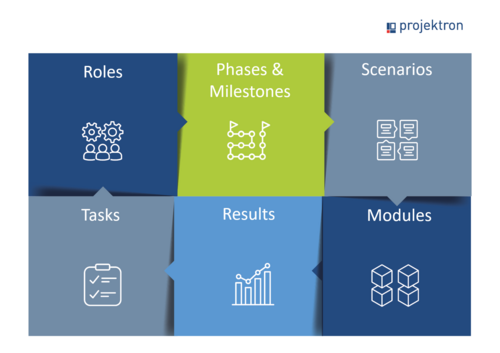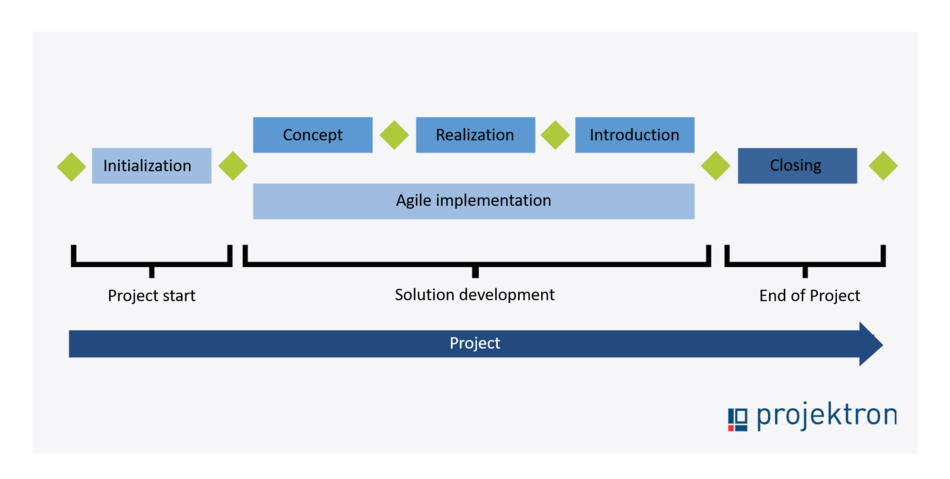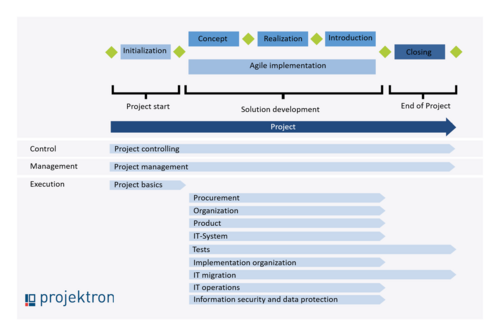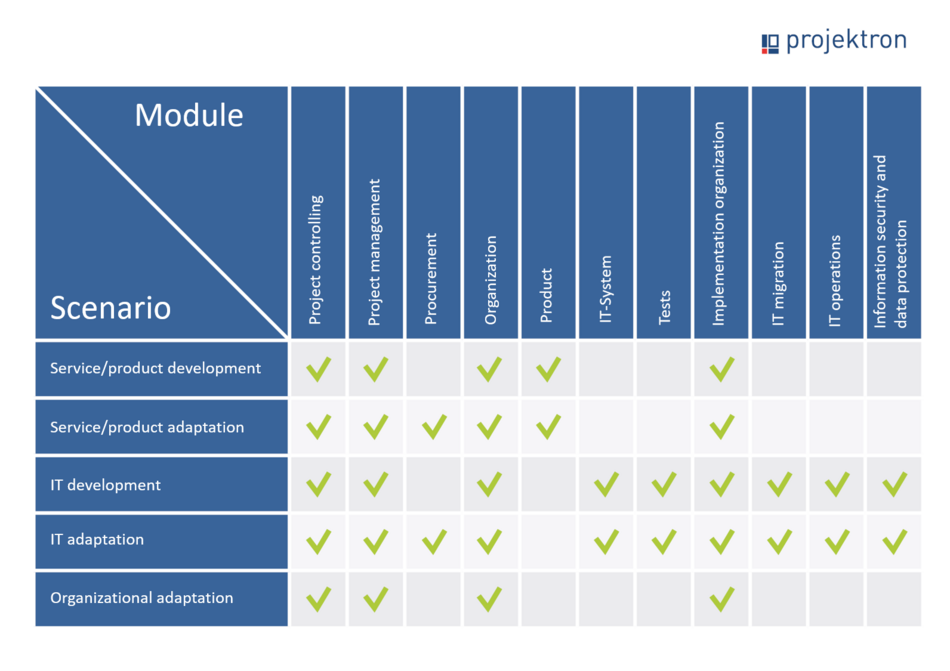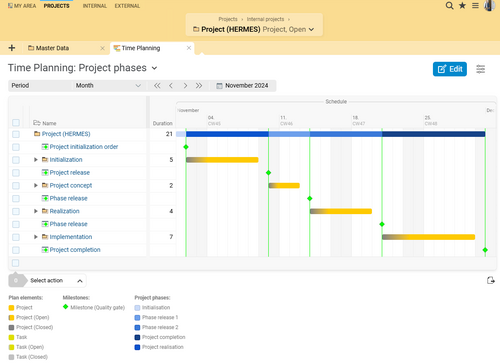04/18/2024 - Articles
HERMES project management: structured flexibility for successful projects
Simply divine: the project management method that is always ready for immediate use, just like the Greek messenger of the gods - HERMES. Learn all about HERMES project management, a method that is widely used in Switzerland and combines clear structures with flexibility. From the basics to certification, discover how to plan, implement and manage HERMES projects efficiently and why the method can also be a valuable asset outside Switzerland.
Contents:
- What is project management according to HERMES?
- Structure of HERMES
- Project phases according to HERMES
- Scenarios and modules in HERMES project management
- Results in HERMES
- Tasks and activities in HERMES projects
- Roles in project management according to HERMES
- Templates for documents and checklists
- What are the strengths of HERMES?
- What are the weaknesses of HERMES?
- What types of projects is HERMES suitable for?
- Which software supports project management according to HERMES?
- Is there a certification for the HERMES project management method?
- Conclusion: HERMES: project management structured and flexible
What is project management according to HERMES?
The HERMES method consists of three components:
- HERMES portfolio management
- HERMES application management
- HERMES project management
This article focuses on project management according to HERMES. This method is widely used in Switzerland. It has been and continues to be developed and published by the Swiss Federal Administration. The name is an acronym for "Handbuch der Elektronischen Rechenzentren des Bundes, eine Methode zur Entwicklung von Systemen". The method is an open standard for the management and execution of IT projects, the development of products and services and the adaptation of business organization.
Outside of Switzerland, HERMES is hardly known or widespread as a project management method. However, it contains many interesting approaches that can also be an enrichment in the context of hybrid project management approaches.
The most important characteristics of HERMES project management
| HERMES can be used for projects of different characteristics and complexity. | |
| HERMES has a modular structure and can be extended. | |
| HERMES is based on a clear method structure. | |
| HERMES is process-oriented and its phase model supports both classic and agile approaches. | |
| HERMES is results-oriented and covers the entire project life cycle. | |
| HERMES is based on a practice-oriented approach and takes into account aspects such as risk management, stakeholder management and quality assurance. | |
| HERMES is also adaptable and can be adapted to different project types and sizes. | |
| HERMES as a method is ready for immediate use as it already provides all the necessary components (e.g. modules, documentation, templates and checklists) to plan and manage a project. |

HERMES is a binding project management method in Switzerland
HERMES effectively supports eGovernment projects at all federal levels in Switzerland (Confederation, cantons and municipalities).
The development of the method began in 1970. HERMES has been used as a project management tool in the Swiss Federal Administration since 1975. After a significant revision in 1986, HERMES became mandatory for all federal IT projects. In 2006, HERMES was recognized as a standard by the eCH association, which promotes and develops e-government standards. Since 2015, all federal agencies have been obliged to adapt and use the HERMES method for their projects, including non-IT projects.
HERMES versions
HERMES is maintained by the Federal IT Steering Unit. The entire HERMES documentation can be downloaded online free of charge at: hermes.admin.ch
Important versions were published in 2013, 2014, 2020 and 2022: HERMES 5, HERMES 5.1, HERMES 2021 and HERMES 2022. Version 5.1 was expanded to include the option of agile development, e.g. with Scrum. In addition to the traditional phased approach, HERMES now also supports an iterative-incremental approach.
The HERMES method was recently completely revised as part of the HERMES 5 project. The focus was on the needs and requirements of users. The result is a new edition that is easier to use and leaner than before:
- The number of project phases has been reduced,
- the roles have been updated and
- predefined scenarios have been introduced that can be easily adapted to specific project processes.
In addition, helpful checklists, templates and an online tool have been provided to support the application of the HERMES project management method.
How are HERMES projects structured?
The structure of HERMES is divided into six parts.
- Phases and milestones: Around the three basic HERMES phases and during the phases, there are milestones that mark results and decisions and ensure that the results are completed on time. Milestones are therefore an important management tool.
- Scenarios: HERMES supports different types of project content and complexity levels with scenarios. Scenarios specify which results must be achieved during the development of the solution. In addition to standard scenarios, individual scenarios can also be designed.
- Modules are reusable building blocks that make up the scenarios. They in turn contain thematically related results and tasks.
- Results are at the heart of HERMES project management. There is a detailed description of the result and a documentation template for each result. Results can be, for example, an integration concept or a process description.
- Tasks are carried out to generate the results. The task consists of several activities that are aimed at producing a result. Examples are Check offer, develop solution architecture, design implementation concept.
- Roles: HERMES has a clearly defined role model. This describes the responsibilities, competencies and skills for each role. Tasks and results are assigned to roles.
What phases does a HERMES project consist of?
Project start: Initialization phase
The initialization phase comprises the following activities:
- Assignment of the project manager: the project client appoints a project manager who is responsible for carrying out the initialization phase.
- Analysis of the situation: A comprehensive analysis of the current situation is carried out, including the general requirements, objectives, context, scope and risks of the project. Various options are considered and a solution is selected, which is described in detail so that it can be evaluated in a transparent and comprehensible manner.
- Stakeholder analysis and conflict resolution: Stakeholder interests are analyzed and potential conflicts are identified and resolved to ensure that all parties are satisfied with the project objectives and outcomes.
- Creation of project charter and management plan: A project charter and project management plan are created, setting out the framework, objectives, resources and project structure. These are submitted to the parent organization for approval.
- Preliminary clarifications and team composition: Preliminary clarifications such as the PIA (project initialization assignment), the catalog of requirements and the ISDS document (information security and data protection) are made, the project team is put together and responsibilities in the team are determined according to the scenario selection, project committee, steering committee, phase budgets, project budgets, etc. are announced.
- Approval and release: After approval by the parent organization and the project sponsor, the project is released for the next phase. This includes the signing of the project contract and the release of the required resources.
- Final check: At the end of the initialization phase, a final check is carried out to ensure that all necessary steps have been completed and the necessary approvals have been obtained before the project moves on to the next phase.
Important results of the initialization phase are
Project initialization order
Stakeholder list
Project management plan
Solution development in phases
According to the classic approach, solution development comprises the following three phases:
Concept
In the concept phase or design phase, the option selected in the initialization phase is concretized and the project team can plan, offer and implement the product or result on a reliable basis. The following steps are taken:
- Designing the concept: the concept is designed on the basis of the selected option in order to plan the product or result in detail. This includes the creation of a preparation plan for deployment and the development of a test plan.
- Procurement (if required): If a product or IT system needs to be procured, this is done in this phase. The required resources are released in accordance with the project management plan and the available offers.
- Development of the integration concept: An integration concept is developed to ensure that the project can be integrated into the existing environment.
- Decision on implementation approval: A decision is made as to whether the project is approved for implementation. The project and operational risks are analyzed and evaluated, and the feasibility of the project is demonstrated.
- Verification of project feasibility: At the end of the concept phase, a check is made as to whether it makes sense to implement the project based on the results of the planning and analysis.
The concept phase enables the project team to create a solid basis for the implementation of the HERMES project and to ensure that all necessary steps and precautions are taken before the actual implementation begins.
Realization
In the realization phase, the product or end result of the HERMES project is actually developed, implemented, parameterized and adapted. The operational organization is implemented and the documentation is prepared. The following steps are taken:
- Preparation of the work: the preparatory work done in the previous phases is crucial to minimize risks during implementation.
- Implementation of business and operational organizations: The required business and operational structures are realized and the corresponding documentation is prepared.
- Deployment preparation: The deployment of the product is prepared, including testing and preparation for migration.
- Release decision: The release for deployment is based on a preliminary assumption and is made on the basis of the information available.
- Resource release: The required resources are released in accordance with the prepared project management plan to ensure that the implementation can proceed smoothly.
- Development risks: The development phase can only proceed if the identified development risks are assessed and deemed acceptable.
The realization phase is critical to the actual implementation of the project and requires careful planning, preparation and execution to ensure that the final product meets requirements and expectations.
Introduction
The introduction phase is the transition to the new state. Here, the operation of the product is started and supported by the project team until it is stable. Training is carried out and migrations are implemented. This includes the following steps:
- Implementation of the deployment measures: The planned measures are implemented and the operational organization is activated to deploy the product or result.
- Support with problem analysis and resolution: The project team provides support in the initial phase to analyze and resolve problems that may arise during deployment.
- Implementation of the migration: The migration to the new system is carried out and the old system is decommissioned.
- Decision on project completion: The sponsor makes the decision to complete the project once operations have started successfully. A decision is made as to whether the project will be completed or whether further results need to be achieved before it can be closed. It is also decided whether the project organization should be dissolved.
If the client decides to close the project, the following measures are taken:
A final project evaluation is prepared
Outstanding items are transferred to the parent organization
The project is officially closed and the project organization is dissolved
Alternative solution development: agile implementation
According to the agile approach, also known as HERMES 2022, the solution development does not comprise the three phases of concept, realization and introduction, but only consists of the "implementation" phase.
The chosen approach is implemented iteratively and step by step. The project organization, including the development team, is defined and the solution requirements are further broken down, refined and specified. The requirements are updated, prioritized and executed (developed, implemented and commissioned) in descending order, with priorities continuously updated and adjusted according to project findings. The result is an increment that builds on all previous results.
Closing phase: end of project
In the closing phase, the project is formally concluded. A final analysis is carried out to check whether the project objective has been achieved. The final report is prepared. Results and documentation are handed over to the parent organization. The project organization, including the committees, is dissolved.
Scenarios and modules in HERMES project management
Different results must be delivered depending on the project type and project objective. HERMES is characterized by its quick applicability for different project types by offering ready-made scenarios.
Szenarios
By default, a scenario contains the method elements that are usually relevant for projects of the respective characteristics. The current HERMES version provides five standard scenarios:
- Service/product development: a new product or service is developed
- Service/product adaptation: a product or service available on the market is acquired, adapted and integrated into an organization
- IT development: development or further development and integration of IT solutions
- IT adaptation: an IT solution available on the market is acquired, adapted and integrated into an organization (e.g. software implementation project)
- Organizational adaptation: projects to set up and restructure the organization of a company
The 12 HERMES modules
Modules are the building blocks that make up the scenarios. They contain all thematically related results and tasks and extend over one or more phases of a HERMES project. There are 12 modules in the HERMES standard:
- Project controlling (entire project duration)
- Project management (entire project duration)
- Project basics (initialization only)
- Procurement (solution development only)
- Organization (solution development only)
- Product (solution development only)
- IT system (solution development only)
- Tests (solution development & completion)
- Implementation organization (solution development only)
- IT migration (solution development & completion)
- IT operations (solution development only)
- Information security and data protection (solution development only)
Results in HERMES project management
Results are at the heart of the HERMES project management method. Results can be very diverse and are divided into 55 documents and 22 statuses.
For documents, HERMES provides document templates for the 55 standard documents that are created in the course of processing tasks during the project phases.
Statuses are points in time at which a result has been achieved. In a project, they usually correspond to the achievement of a milestone. Examples of the 22 standard statuses are "Operation activated", "Migration completed" or "Interfaces implemented".
However, in addition to the standard documents and standard statuses, you can define company or project-specific results.
Tasks and activities in HERMES
In order to produce results, tasks are completed during the course of the project. A task, in turn, can be broken down into several activities that are necessary for its completion. According to the HERMES project management methodology, two types of tasks can be distinguished:
- Decision tasks: Lead to a decision and end with a result milestone (e.g. make acceptance, issue phase release); there are 16 different decisions in the HERMES standard
- Other tasks: Create the project product over the course of the phase (e.g. manage risks, develop agreements, realize product, perform test); there are 50 different other tasks in the HERMES standard
Roles in project management according to HERMES
HERMES comprises a complete role model with roles for both the core organization and the project organization. The roles are subdivided into a hierarchical structure with the hierarchy levels "Control", "Management" and "Execution".
Control roles steer the project
- Client
- Project committee
- Quality and risk manager
Management roles are responsible for operational implementation
- Project manager
- Sub-project manager
- Project support
- Technical committee
- Execution roles create the project product
Execution roles create the project product
- User representative
- Operations manager
- Business analyst
- Developer
- Development team
- ISDS manager
- IT architect
- Tester
- Test manager
For each role, the HERMES reference manual contains a detailed description of responsibilities, competencies, necessary skills and relevant tasks.
Templates for HERMES documents and checklists
Templates for every document and every result ensure that HERMES is immediately ready for use in your project. The templates contain outlines and meaningful content structures for almost every conceivable use case. They serve as a guideline to which you can align your project planning. These document templates include, for example, change request, quotation, project management plan, test protocol, test concept, test protocol and much more.
Ready-made checklists make it easy to check milestones. Examples of checklist templates include "Project completion", "Project termination", "Release approval", "Migration acceptance" and many more.
What are the strengths of HERMES?
The strengths of HERMES lie in its adaptability and flexibility. HERMES can be adapted to different project types and sizes, taking into account the specific requirements and needs of the project and the organization. With the sizing and tailoring functions, you can tailor the method precisely to your needs.
Sizing helps to bring the method to the right size by adapting the documentation requirements to the value of the project.
Tailoring makes it possible to customize standard scenarios, remove or add modules and thus realize tailor-made project management.
Another advantage of HERMES is that it is a process-oriented approach that clearly structures and defines the phases of project management. This enables the project to be carried out systematically and efficiently.
HERMES is also strongly focused on stakeholder communication and involvement. By clearly defining and involving the relevant interest groups, conflicts can be avoided and better acceptance of the project can be achieved.
The method also emphasizes risk management and quality assurance, which can help to minimize the risk of errors and failures in the project.
Finally, HERMES also provides a clear definition of roles and responsibilities in the project team, which facilitates collaboration and coordination and contributes to the successful completion of the project.
What are the weaknesses of HERMES?
One of the weaknesses of HERMES can be that the method can be very extensive and complex. This can make it difficult for inexperienced project managers to familiarize themselves with the method and its application.
Another problem can be that HERMES is very formalized and can make it difficult for project managers to focus on the actual needs and challenges of the project. Sometimes the focus can be too much on adhering to the methodology and less on the actual implementation of the project.
Another disadvantage of HERMES is that it may not be as widely used or recognized as other project management methodologies such as GPM / IPMA, PMI or PRINCE2 due to its origin and prevalence in Switzerland.
Finally, the adaptability of HERMES can also become a disadvantage, as it can be difficult for inexperienced project managers to effectively adapt the method to their needs and challenges. In some cases, this can lead to an overuse of the method, resulting in an inefficient implementation of the project.
What types of projects is HERMES suitable for?
HERMES is suitable for a wide range of projects and can be applied to various industries and areas of application. The method is particularly suitable for medium to long-term projects that require a clear structure and organization.
HERMES is particularly suitable for complex projects with many participants and stakeholders where clear communication and coordination is required. The method is also suitable for high-risk projects where systematic risk management is required.
In terms of industries, HERMES is particularly suitable for projects
- in public administration
- in the education sector and
- in the healthcare industry
These industries often have high requirements for transparency and documentation, which can be ideally mapped using HERMES.
Overall, however, HERMES is flexible enough to be adapted to different project types and sizes. Therefore, it can be used for a variety of projects in different industries as long as a structured and systematic execution of the project is required.
Which software supports project management according to HERMES?
Projektron BCS offers a comprehensive and flexible solution for the implementation of HERMES projects. From project planning, phase and task management to agile development and resource planning, the software supports you in every step of HERMES project management:
- Customizable templates: With Projektron BCS, you can easily map standard scenarios and HERMES project planning templates in the software and adapt them to the needs of your organization and your projects. The flexible customization of your HERMES templates saves you time and allows you to concentrate better on the project content.
- Clear phase planning with milestones: The software enables structured phase and task planning with clear milestones as quality gates. This allows you to keep track of project progress and intervene in good time if necessary.
- Efficient workflows and checklists: Projektron BCS supports you with system-controlled workflows and checklists for decisions, approvals and work organization. These enable structured project implementation and ensure quality.
- Agile project management with Scrum: The software offers support for agile development methods according to HERMES, in particular with the Scrum framework. A digital scrum board and a clear burndown chart help with the effective implementation of agile projects.
- Flexible role model and organizational structures: Projektron BCS allows you to define your own role model that meets the requirements of your HERMES project. With flexible organizational structures and detailed role descriptions, you retain control over the project organization.
See for yourself and test the HERMES project management software Projektron BCS right now, free of charge and without obligation.

Daniel Sdiri, BCS application manager, ISCeco - Information Service Center WBF
"After our project managers had already been using the planning functions, all our employees have been using Projektron BCS since March 2010. The product quickly gained widespread acceptance and has proven to be a reliable partner in everyday work over the years. The system now forms the basis for numerous processes and evaluations in the areas of project management, customer support, controlling and management. The uncomplicated flexibility that BCS offers when configuring the user interface, adding new fields and querying data is particularly important to us."
Is there a certification for the HERMES project management method?
The certification for the HERMES project management method is offered by the Swiss Association for Project Management (SVP) and is for project managers who wish to demonstrate their competencies and skills in the field of project management according to HERMES.
The certification comprises two levels:
- Foundation Level, also known as Basic Level, is a test of basic knowledge of the HERMES project management methodology.
- Advanced Level, also known as Intermediate Level, is a test of advanced knowledge of the HERMES project management methodology.
Each level requires a certain level of experience and knowledge of HERMES project management and includes a written exam and a practical exam.
The certification offers project managers the opportunity to improve their HERMES project management skills and demonstrate their competencies. It can also serve as a valuable tool for career development in organizations that apply HERMES.
Conclusion: HERMES: project management structured and flexible
Overall, the HERMES project management method offers a structured and comprehensive approach to the planning, implementation and management of projects. With its clear method structure, process-oriented approach and focus on stakeholder management and quality assurance, HERMES enables the effective implementation of projects of varying size and complexity.
Thanks to its overall structure with phases & milestones, scenarios, modules, results, tasks, roles and templates, HERMES is one of the few project management methods that can be used directly to implement a project without prior implementation, training and adaptation.
The method is characterized by its modularity and adaptability, allowing it to be flexibly adapted to different project types and requirements. With its standardized scenarios, modules, results, tasks and roles, HERMES offers a comprehensive framework for project work.
The continuous development and updating of HERMES, such as the introduction of agile development options and the integration of new standards, ensures that the method meets the changing requirements and best practices in project management.
Despite its strengths, HERMES also has some weaknesses, such as its complexity and formality, which can make it difficult for inexperienced project managers to familiarize themselves with and use. Nevertheless, HERMES remains a recognized and widely used project management method in Switzerland and has the potential to be an asset to hybrid project management approaches internationally.
Overall, HERMES is a powerful method that enables the structured and effective implementation of projects and has established itself as a binding project management method in Switzerland.

About the author
In the marketing department of Projektron GmbH, employees use the functions of Projektron BCS on a daily basis to support their projects and workflows. As an editor in the marketing department, Kai Sulkowski is always up to date with the latest developments and innovations in project management and work organization.
More interesting articles in the Projektron blog
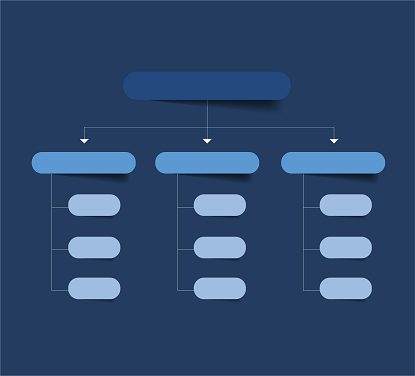
Project structure planning
It is considered the plan of plans or the mother of all plans in classic project management: the work breakdown structure (WBS). Find out how you should proceed when creating a work breakdown structure here.
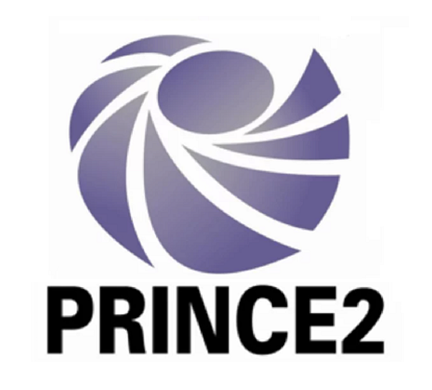
PRINCE2 in project management
PRINCE2 is a process-oriented PM method, can be scaled and places the benefits of a project at the center of project management. Our specialist article provides an introduction to the basic idea, strengths and weaknesses of the PRINCE2 method.
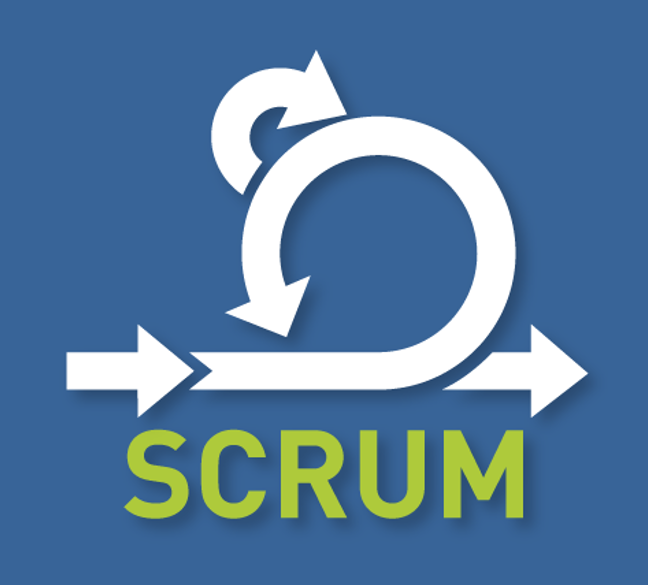
Scrum in software development
When it comes to agile software development methods, there is one term you cannot avoid: Scrum. But what exactly is Scrum and how does it develop its strengths in software development?

Hybrid PM
Classic or agile? If the decision between these two approaches is difficult, a combination of two or more project management methods is probably the right way to go. Find out everything you need to know about hybrid project management in this article.
